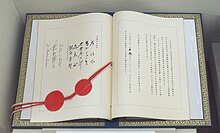Treaty of Mutual Cooperation and Security between Japan and the United States
The Treaty on Mutual Cooperation and Security between Japan and the United States ( Engl. : Treaty of Mutual Cooperation and Security between the United States and Japan , Japanese. 日本国とアメリカ合衆国との間の相互協力及び安全保障条約, Nihon-koku to America-gasshūkoku tono aida no sōgo kyōryoku oyobi anzen hoshō jōyaku ) is a treaty that was signed between the USA and Japan on January 19, 1960 in Washington. He strengthened Japan's ties to the " West " during the Cold War era . The treaty also included general wording for the future development of international cooperation and improved economic cooperation.
Origins
The previous Mutual Security Treaty of 1952 formed the basis of Japan's security relations with the United States after the regaining of full sovereignty after the end of the occupation .
Bilateral talks to revise the 1952 Security Pact began in 1959 and the new treaty was signed in Washington on January 19, 1960.
Large demonstrations and student protests in 1960
When the pact was submitted to the Japanese Parliament for ratification on February 5, a bitter debate erupted over US-Japan relations, with the left opposition making every effort to use violent means to prevent ratification. It was finally approved by the House of Commons of Japan on May 20. Japanese Socialist Party MPs boycotted the lower house sessions and tried to prevent LDP MPs from entering the house. They were forcibly removed by the police. Massive demonstrations and rioting by students and unions followed, one student died in clashes with police and over 500 people were injured. The demonstrations prevented President Dwight D. Eisenhower from visiting Japan and resulted in the resignation of Prime Minister Kishi Nobusuke , but not before the treaty was automatically ratified on June 19, as the Japanese House of Lords did not meet within the required 30 days after the approval of the House of Commons had voted on the treaty.
The contract is known in Japan as ampo ( 安 保 , a contraction of 安全 保障 , anzenhoshō ), and the student movements against the contract in the 1960s and 1970s became known as ampo hantai . You can also find the spelling anpo .
content
The treaty obliges both parties to maintain and develop their capacities to jointly resist an armed attack. An armed attack on one of the two countries and on a territory under Japanese administration would be considered dangerous to the security of the other country. However, because of its constitutional prohibition on participating in external military operations, Japan was exempted from the obligation to defend the United States if it were attacked outside Japanese territory.
In addition, Article 10 of the treaty states that the agreement will become obsolete once the United Nations collective security system comes into force.
The new treaty did not cover the Ryūkyū Islands , but an appendix made it clear that if the islands were attacked, both governments would consult and take appropriate action. In contrast to the contract of 1952, a 10-year term was agreed, after which it could be canceled by either party with one year's notice. In 1970 the contract was extended.
The controversial Article 6 of the treaty contains approval of the stationing of American armed forces in Japan, the United States Forces Japan , and the provision of bases and regulates the administration of Japanese citizens employed in the facilities of the US armed forces.
The protocol note to the treaty stipulated that the Japanese government should be "consulted" prior to major changes to the US troop stationing in Japan or the use of Japanese bases for combat purposes outside the defense of Japan itself. The boundaries of jurisdiction in prosecuting crimes committed by members of the US military in Japan were also set.
The 1952 treaty originally consisted of a military aid program designed to provide Japan with the means, materials and services necessary to defend the country. Although Japan ceased to receive aid from the US in the 1960s, this contract continued to serve as the basis for purchases and licensing agreements for weapon systems compatibility and for the transmission of classified information to Japan, including international intelligence reports and classified technical information.
Web links
- Official website of the United States Forces Japan on the 50th anniversary of the signing of the agreement
- Country study on Japan of the Library of Congress of the United States (English)
